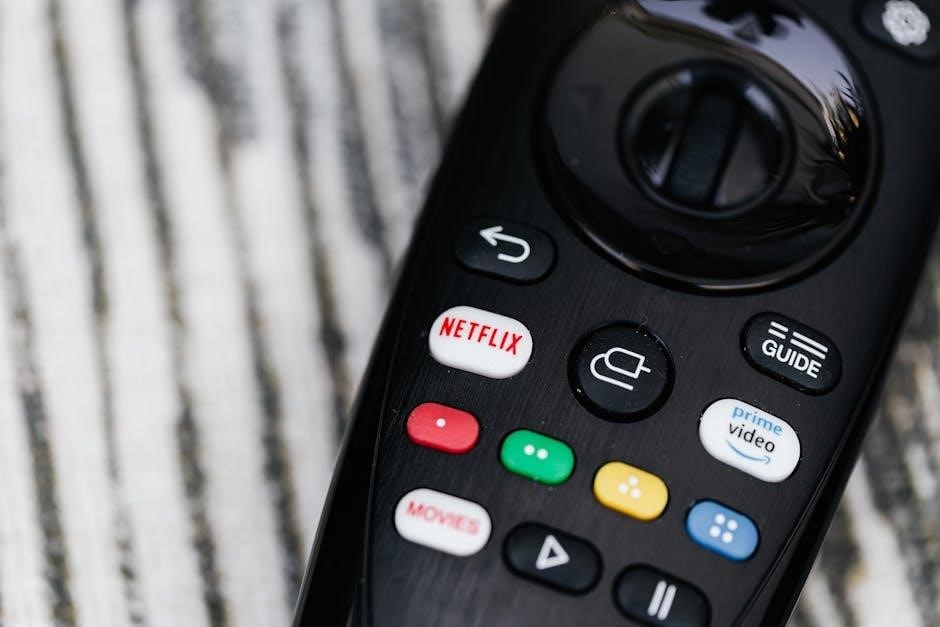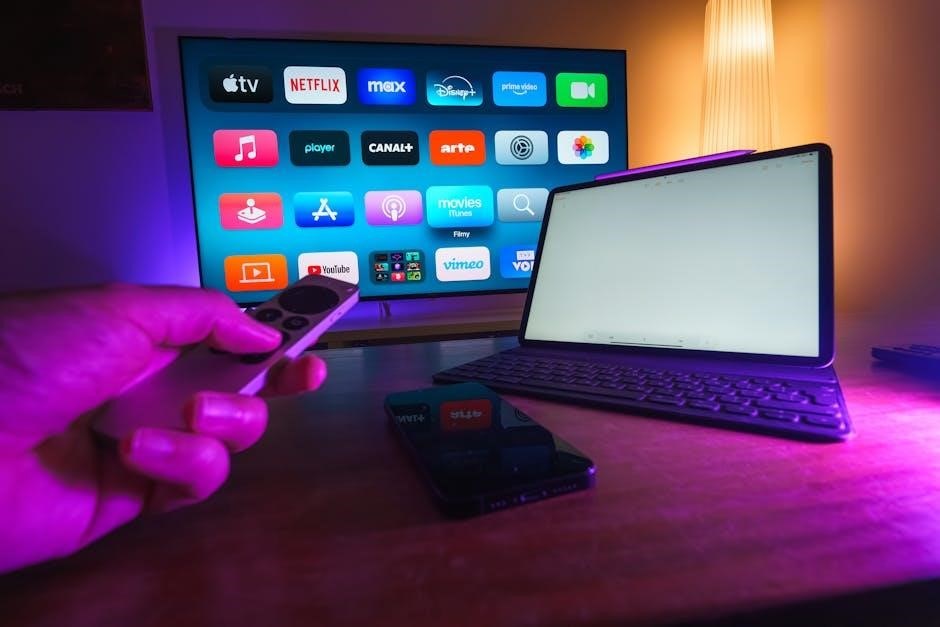Access TV Channel Guide PDF: A Comprehensive Overview

Accessing a TV channel guide in PDF format offers a convenient way to browse listings. Many providers offer downloadable PDFs detailing channel lineups. These guides help in planning your viewing and discovering new content. The guides often include channel numbers and programming information.
Understanding Access TV and Channel Guides
Access TV refers to television channels that provide community-based programming. These channels often feature local content, public affairs shows, and educational programs. Understanding how these channels operate within the broader TV landscape requires familiarity with channel guides. Channel guides, whether electronic or in PDF format, are essential tools for navigating the numerous channels available.
The traditional purpose of a channel guide is to provide a structured listing of available channels and their corresponding programming schedules. With the advent of digital TV, electronic program guides (EPGs) have become common, offering real-time updates and interactive features. However, PDF channel guides still hold value, offering a portable and easily shareable reference for viewers. They allow users to quickly see what is on without needing to turn on the TV.
Access TV listings within these guides help viewers find local programming. This content often differs significantly from standard cable or satellite offerings, providing a platform for local voices and community events.
Accessing the Electronic Program Guide (EPG)
The Electronic Program Guide (EPG) is a digital interface built into most modern televisions and set-top boxes. It provides an on-screen guide to current and upcoming television programs. Accessing the EPG is typically done by pressing a dedicated “Guide” button on your remote control. This button usually brings up a comprehensive listing of channels and their scheduled programming.
Navigating the EPG is usually straightforward, with options to scroll through channels and time slots. Many EPGs also offer search functions, allowing you to find specific programs or genres. Some advanced EPGs provide additional features, such as program descriptions, parental controls, and the ability to set reminders for upcoming shows.
The information displayed in the EPG is usually updated automatically, ensuring that you have the most current listings. However, it’s important to note that the accuracy and availability of the EPG can vary depending on your TV provider and location. If the EPG isn’t working properly, check your TV’s settings or contact your provider for assistance.
Navigating the Channel Guide Interface
The channel guide interface is your primary tool for finding and selecting TV programs. Typically, the interface is accessed by pressing a “Guide” button on your remote control. Once open, the guide displays a grid-like layout, with channels listed vertically and time slots displayed horizontally. Use the arrow buttons on your remote to move through the grid, highlighting different programs and channels.
When a program is highlighted, additional information is usually displayed, such as the program title, a brief description, and the start and end times. Many guides also offer options to filter channels by category (e.g., sports, movies, news) or to search for specific programs by title or keyword. Some advanced interfaces provide personalized recommendations based on your viewing history.

Pay attention to the symbols and icons within the guide. They may indicate program ratings, availability in HD, or whether a program can be recorded. Learning to interpret these visual cues will enhance your navigation experience; If you’re having trouble with the interface, consult your TV or service provider’s manual for detailed instructions.
Troubleshooting Common Channel Guide Issues

Encountering issues with your TV channel guide can be frustrating, but many problems have straightforward solutions. One common issue is a missing or incomplete guide. This often occurs after a power outage or when the TV hasn’t been used for a while. Try restarting your cable box or TV to refresh the guide data.
If the guide is slow or unresponsive, it could be due to a weak signal or outdated software. Check your cable connections and ensure your TV’s software is up to date. Some guides may require a subscription or activation. Verify that your account is active and properly configured.
Another problem is incorrect or missing channel information. This can happen if the channel lineup has changed or if there’s a temporary glitch in the system. Contact your service provider to report the issue and request an updated channel guide. If you’re using an antenna, rescan for channels to ensure you have the latest listings. When all else fails, consult the TV’s manual.
Channel Lineup and Availability

Understanding channel lineup and availability is crucial for optimizing your TV viewing experience. The specific channels you receive depend on your service provider and subscription package. Basic packages typically include local broadcast channels and a selection of popular networks. Expanded packages offer a wider range of options, including sports, movie, and specialty channels.

Channel availability can vary by region. Always check your provider’s official channel lineup for the most accurate information. Some channels may only be available in HD, requiring a compatible TV and receiver. Premium channels, like HBO or Showtime, usually require an additional subscription fee.
New channels are frequently added, and existing channels may change their positions. Regularly review your channel guide or contact your provider for updates. Online channel finders can also help you locate specific channels within your lineup. Public access channels may also be available.
Digital TV Channel Access
Accessing digital TV channels has become the standard for modern television viewing, offering enhanced picture and sound quality compared to analog. To access digital channels, you typically need a digital TV or a digital converter box connected to an older analog TV. Ensure your TV is set to the correct input source.
Digital TV signals can be received via cable, satellite, or over-the-air (OTA) broadcasts using an antenna. Cable and satellite providers offer digital channel lineups as part of their subscription packages. OTA digital channels are free to access with a properly installed antenna. Channel scanning is essential for discovering available digital channels.

The electronic program guide (EPG) is a key feature of digital TV, providing on-screen listings and scheduling information. Navigate the EPG using your remote control’s guide button. Digital TV also supports interactive features, such as pausing live TV and accessing on-demand content.
Using the Guide Button on Your Remote
The “Guide” button on your TV remote is your gateway to accessing the electronic program guide (EPG). Pressing this button typically brings up an on-screen display of channel listings and program information. The EPG allows you to see what’s currently playing on each channel and what’s scheduled for later.
Navigating the EPG is usually done with the arrow keys on your remote. You can scroll through channels and time slots to find programs of interest. Some remotes also have page up/down buttons for faster navigation. The “Info” button, often located near the “Guide” button, provides additional details about a selected program.
The guide button’s functionality can vary slightly depending on your TV provider or device. Some guides offer advanced features like setting reminders or recording programs directly from the EPG. Familiarize yourself with your remote’s manual to fully utilize the guide button’s capabilities. If the guide button isn’t working, check your remote’s batteries or consult your TV’s troubleshooting section.
Accessing Channel Guides Online
Many TV providers offer online channel guides on their websites. These online guides provide a convenient way to browse listings from your computer or mobile device. Typically, you’ll need to visit your provider’s website and log in to your account to access the guide.
Online channel guides often offer advanced features compared to the on-screen EPG. You can usually search for specific programs or channels, set reminders, and even schedule recordings remotely. Some providers also offer personalized recommendations based on your viewing history.
In addition to provider websites, third-party websites and apps also offer comprehensive TV listings. These services often aggregate data from multiple providers, allowing you to search for programs across different platforms. Some popular options include TV Guide, Zap2it, and others. Be aware that the accuracy and completeness of these third-party guides may vary. Always verify listings with your provider’s official guide for the most up-to-date information.
Spectrum TV Channel Guide Information
Spectrum TV provides multiple ways to access their channel guide, ensuring customers can easily find their favorite programs. Customers can access the guide through their Spectrum set-top box using the remote control. The on-screen guide allows browsing channels, viewing program details, and setting recordings.
Spectrum also offers an online channel guide accessible through their website or mobile app. This online guide allows users to view listings, search for shows, and manage their DVR recordings remotely. To access the online guide, customers typically need to log in to their Spectrum account.
Furthermore, Spectrum may provide a downloadable PDF version of their channel lineup. This PDF can be helpful for quickly referencing channel numbers and categories. To find the PDF, visit the Spectrum website and look for a “Channel Lineup” or “TV Guide” section. Keep in mind that channel lineups can vary by location, so ensure you are viewing the correct guide for your area. Spectrum frequently updates its channel guide, so check for the latest version regularly.

Public Access TV and Channel Listings
Public access television channels offer a unique platform for community-driven content. Unlike commercial networks, public access channels feature programming created by local residents and organizations. These channels often showcase diverse perspectives, including educational programs, community events, and independent productions.
Finding channel listings for public access TV can sometimes be a bit different than locating standard cable or satellite channels. Many public access stations maintain their own websites where they publish schedules and program information. These websites often include a downloadable PDF of the channel lineup and programming details for the week or month.

Additionally, local government websites or community bulletin boards may provide information on public access channel listings. Another option is to contact your local cable provider, as they are often required to carry public access channels and may include them in their channel guide. Keep an eye out for community newsletters or newspapers, which sometimes feature public access TV schedules. Exploring these resources will help you discover the unique and engaging content offered by your local public access channels.

Alternative Methods for Accessing TV Listings
Beyond traditional printed guides and electronic program guides (EPGs), several alternative methods exist for accessing TV listings. Online TV guide websites and apps offer comprehensive listings that are updated frequently. These platforms often allow users to personalize their guide based on their provider and location. Many also feature search functions, allowing users to quickly find specific programs or channels.
Streaming services often integrate live TV options, providing access to channel listings within their interfaces. These services may offer curated guides or personalized recommendations based on viewing habits. Social media platforms can also be a source for TV listings, with some channels or programs announcing schedules on their official pages.
For those who prefer a more hands-on approach, over-the-air (OTA) antennas paired with digital TV recorders can provide access to local channels and their program guides. Some smart TVs also offer built-in TV guide apps or integrations with online listing services. Exploring these alternative methods can enhance your TV viewing experience and provide convenient access to the information you need.


